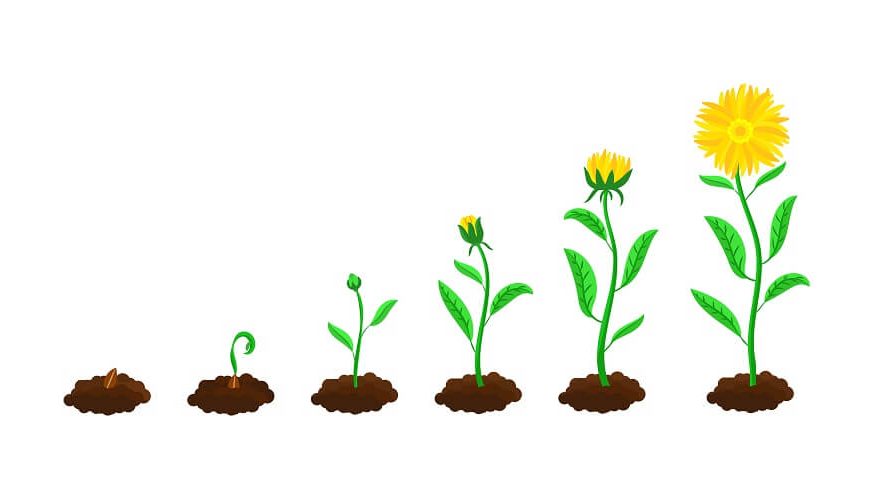Teaching children about the plant life cycle is a beautiful way to connect them with nature, helping them understand the processes by which plants grow, reproduce, and eventually complete their life cycle. The plant life cycle for kids can be both an educational and enjoyable subject, especially if hands-on and interactive activities are incorporated. This article highlights some of the most engaging plant life cycle activities for kids to delve into.
What is Germination?
Germination is the process by which a seed develops into a new plant. It occurs when the conditions are suitable for the seed to sprout, such as the presence of water, oxygen, and the right temperature. This process is essential for the growth and reproduction of plants.
Steps of Germination:
- Imbibition:
- Enzyme activation:
- Radicle emergence:
- Shoot development:
- Establishment:
The seed absorbs water, causing it to swell. This process activates the enzymes within the seed and kickstarts germination.
The enzymes within the seed break down stored food reserves, converting them into energy for the growing plant.
The radicle, or embryonic root, is the first part of the plant to emerge from the seed. It penetrates the soil to anchor the plant and absorb water and nutrients.
The shoot, or embryonic stem, starts to grow upwards towards the surface. It carries the cotyledons, which are the seed’s initial leaves, above the ground to begin photosynthesis.
The seedling establishes itself as an independent plant, producing roots, leaves, and stems to support growth and reproduction.
Germinate in a Jar:
To germinate seeds in a jar, follow these simple steps:
- Place a layer of damp paper towels or cotton wool at the bottom of a clean, transparent jar.
- Spread seeds evenly across the damp surface, ensuring they do not overlap.
- Seal the jar with a lid or plastic wrap to maintain humidity.
- Store the jar in a warm, dark place, and check regularly for signs of germination.
- Once the seeds have sprouted, carefully transfer them to a suitable growing medium, such as soil or compost.
Sort Sprouted Seeds:
Sorting sprouted seeds involves separating the germinated seeds from those that have not yet sprouted. This is usually done by hand, using tweezers or a small, blunt instrument to avoid damaging the delicate roots and shoots.
Personal Germination Station:
A personal germination station is a dedicated space in your home or garden for nurturing germinated seeds. It can be as simple as a windowsill with good sunlight exposure or a more elaborate setup with grow lights, heat mats, and humidity control.
Conduct a Plant Dissection Experiment:
A plant dissection experiment involves carefully cutting apart a plant to study its internal structures and functions. This activity helps to understand the anatomy of plants and the processes involved in their growth and development.
Discover Why Seeds Have Coats:
Seeds have coats, or seed coverings, to protect the delicate embryo inside. Seed coats provide a barrier against physical damage, extreme temperatures, and pests. They also control the absorption of water, ensuring that germination only occurs when conditions are favourable.
Plant Study Field Trip:
A plant study field trip is an educational outing where participants visit a natural environment, such as a forest, meadow, or botanical garden, to observe and learn about plants in their natural habitat. Such field trips can involve guided tours, hands-on activities, and opportunities to explore and investigate various plant species.
Some of the most engaging plant life cycle activities for kids to delve into.
- Seed Germination in a Clear Bag
- Lifecycle Sticker Book
- Plant Life Cycle Wheel
- Seed Mosaic Artwork
- Interactive Plant Life Cycle Game
- Garden Journal
- Storytelling Session: The Life of a Plant
- Edible Plant Life Cycle
- Plant Life Cycle Dance
- Interactive Plant Life Cycle App Exploration
Understanding the early stages of the plant life cycle is foundational. Begin with the simple activity of seed germination in a clear plastic bag.
Materials: A clear plastic sandwich bag Cotton wool or paper towels Water Seeds (e.g., beans or sunflowers) Procedure:
Moisten the cotton wool or paper towel. Place the seeds on the wet cotton or paper towel. Slide the setup into the plastic bag. Seal the bag and tape it to a sunny window. Observe the germination process over a few days. This is a fantastic way to visibly introduce the first of the plant life cycle stages.Kids love stickers! Creating a sticker book dedicated to the plant life cycle for kids can be a fun project that promotes learning. Materials: A blank notebook Stickers depicting various plant life cycle stages Coloured pens Procedure: Let the children pick a sticker representing a stage in the plant life cycle. Encourage them to stick it in their book and label it. Ask them to draw or write a few lines about that particular stage.
To visualise all the plant life cycle stages in a circular representation, craft a lifecycle wheel. Materials: Two pieces of card paper A split pin Colouring supplies Printed stages of plant life cycle Procedure: Cut one of the card papers into a large circle. This will be the base. From the second card paper, cut out a smaller circle and then a pie-like section from it. This will serve as the rotating cover. Attach the smaller circle on top of the larger one using a split pin at the centre. On the larger circle, write or paste the stages of the plant life cycle around it. Rotate the smaller circle to reveal each stage sequentially.
This is a brilliant fusion of art with plant life cycle activities, ensuring a fun-filled experience. Materials: Various types of seeds Card paper or a canvas board Glue Procedure: Draw an outline of a plant or flower on the card paper. Apply glue in different sections of the artwork. Ask the children to fill the sections using different seeds. Once dried, discuss how each seed type has its unique life cycle.
Children tend to enjoy interactive activities, and what better way than a game to teach the plant life cycle for kids? Materials: A dice Printouts or drawings of the different plant life cycle stages Tokens for each player Procedure: Place the printouts in a sequence, mimicking a board game. Each player starts with a seed stage and rolls the dice to move ahead. The goal is to complete the life cycle and discuss each stage as they progress.
For a prolonged plant life cycle activity, let children maintain a garden journal. Materials: A blank journal or notebook Pens, pencils, and other drawing materials Procedure: Encourage children to plant seeds in a garden or pots. Every week, ask them to draw the growth and write observations in the journal. Discuss and celebrate the plant as it progresses through its life cycle stages.
Narrative is a powerful tool to impart knowledge, especially when it comes to explaining processes like the plant life cycle for kids. Materials: A picture book detailing the plant life cycle stages (or you can create your own!) Props or puppets, if available Procedure: Start the story from a seed’s perspective. Describe its longing to sprout and grow.
As the story progresses, delve into the experiences of the seed – the thrill of germination, the emergence of the first green shoots, and its journey towards becoming a full-grown plant.
For added engagement, use the props or puppets to visualise each stage. Encourage kids to join in and retell parts of the story in their own words.
Engaging children’s senses is a fantastic way to enhance learning. An edible representation of the plant life cycle stages is not only educational but also delicious!
Materials: A plate Different edible items representing stages: seeds (sunflower seeds), sprouts (bean sprouts), flowers (cauliflower florets), fruit (grapes or berries) Procedure: Place each edible item on the plate corresponding to the plant life cycle stages. Discuss each stage with the children, and let them eat the edible items as they understand each phase.Combine movement and learning in this delightful plant life cycle activity. Procedure: Start by explaining that everyone will be acting out the plant life cycle through dance. Seed stage: Everyone curls up tight on the floor. Germination: Slowly wiggle a finger or hand to represent the first shoots. Growth: Children stand up, slowly stretching their arms and legs. Flowering: Children dance freely, waving their arms to mimic blooming flowers. Fruit/Seed Production: Children form a circle, representing the completion and restart of the cycle. Play music to make the activity more enjoyable. This kind of kinetic learning ensures that the concept sticks and is recalled more easily.
In this digital age, a myriad of educational apps is designed to help children understand complex processes in an interactive manner. Procedure: Download a well-reviewed plant life cycle app tailored for children. Spend time together exploring the app. Let the children take the lead, clicking through different plant life cycle stages. Discuss what they’ve learned and compare with the physical activities they’ve done.
Conclusion
Plant life cycle activities for kids can be as diverse and interactive as one’s imagination permits. Whether your child is artistically inclined or loves hands-on experiments, there’s an activity to capture their interest. By engaging in these activities, children not only understand the plant life cycle stages better but also develop a deeper appreciation for nature.
At EuroKids, we believe in nurturing young minds with hands-on learning, and our fun and engaging plant life cycle activities for kids are designed to do just that. We seamlessly blend education with play, ensuring our little ones connect with nature while understanding the wonders of growth. Dive into our creative modules and watch your child’s curiosity blossom!















